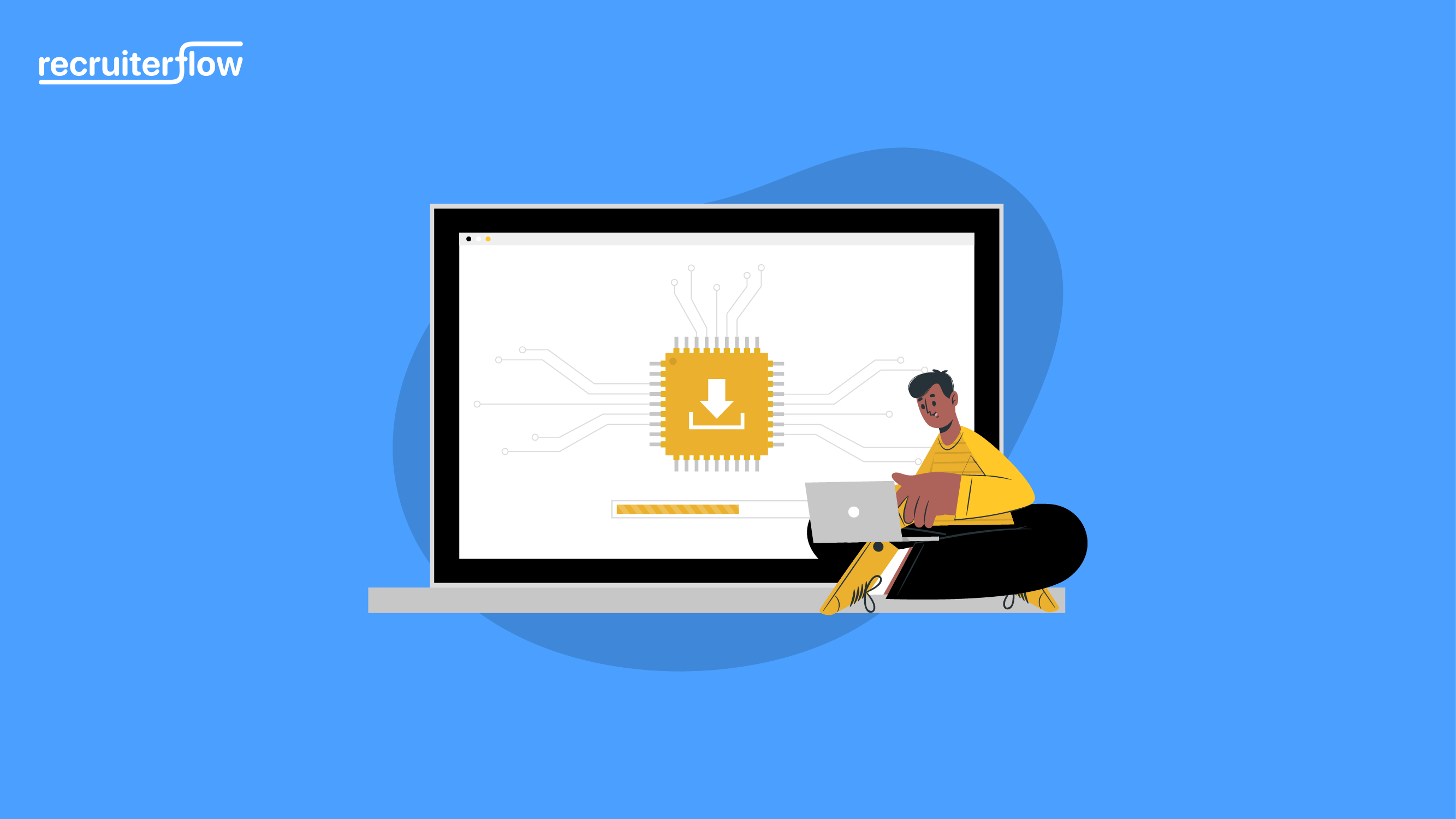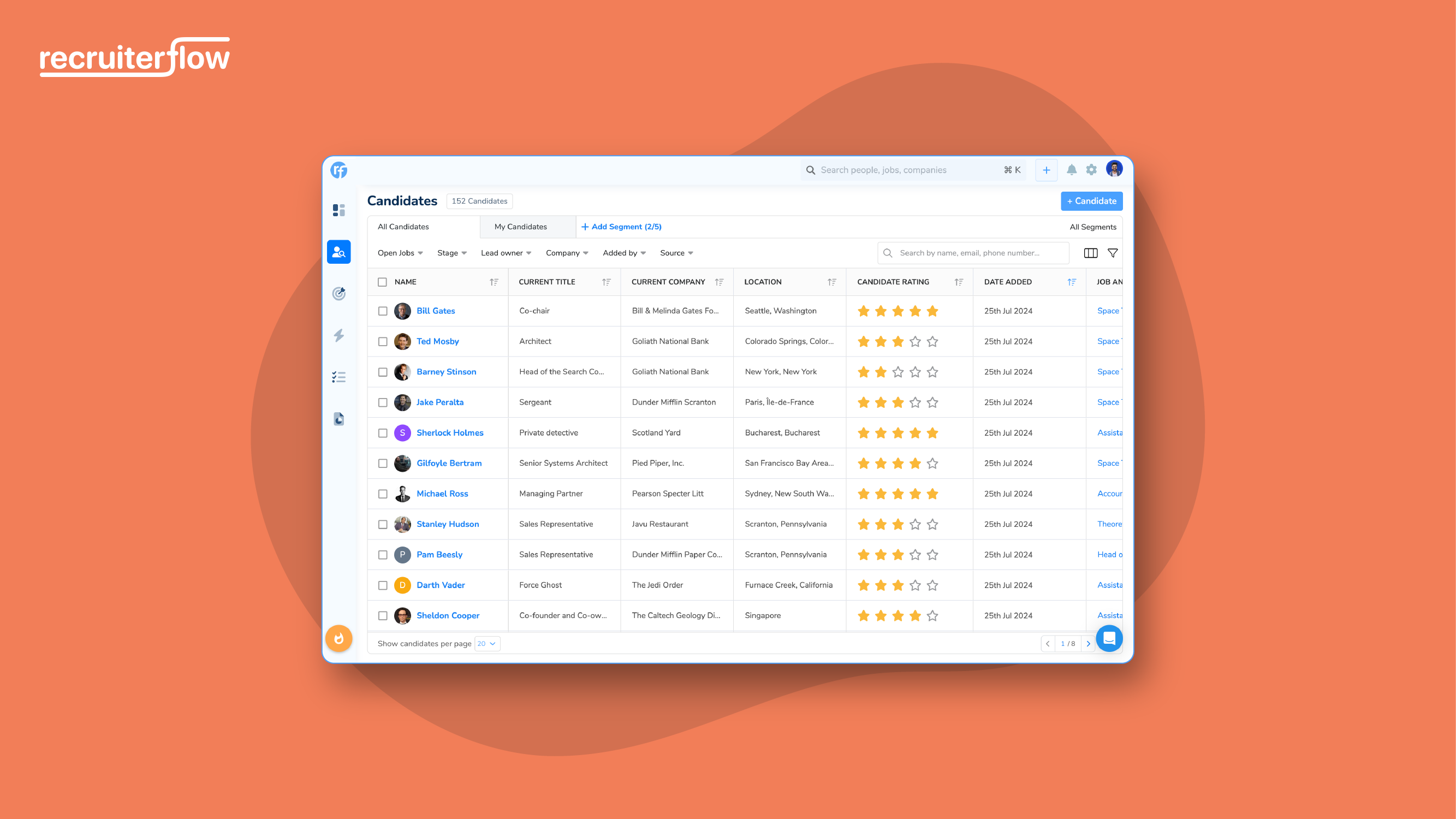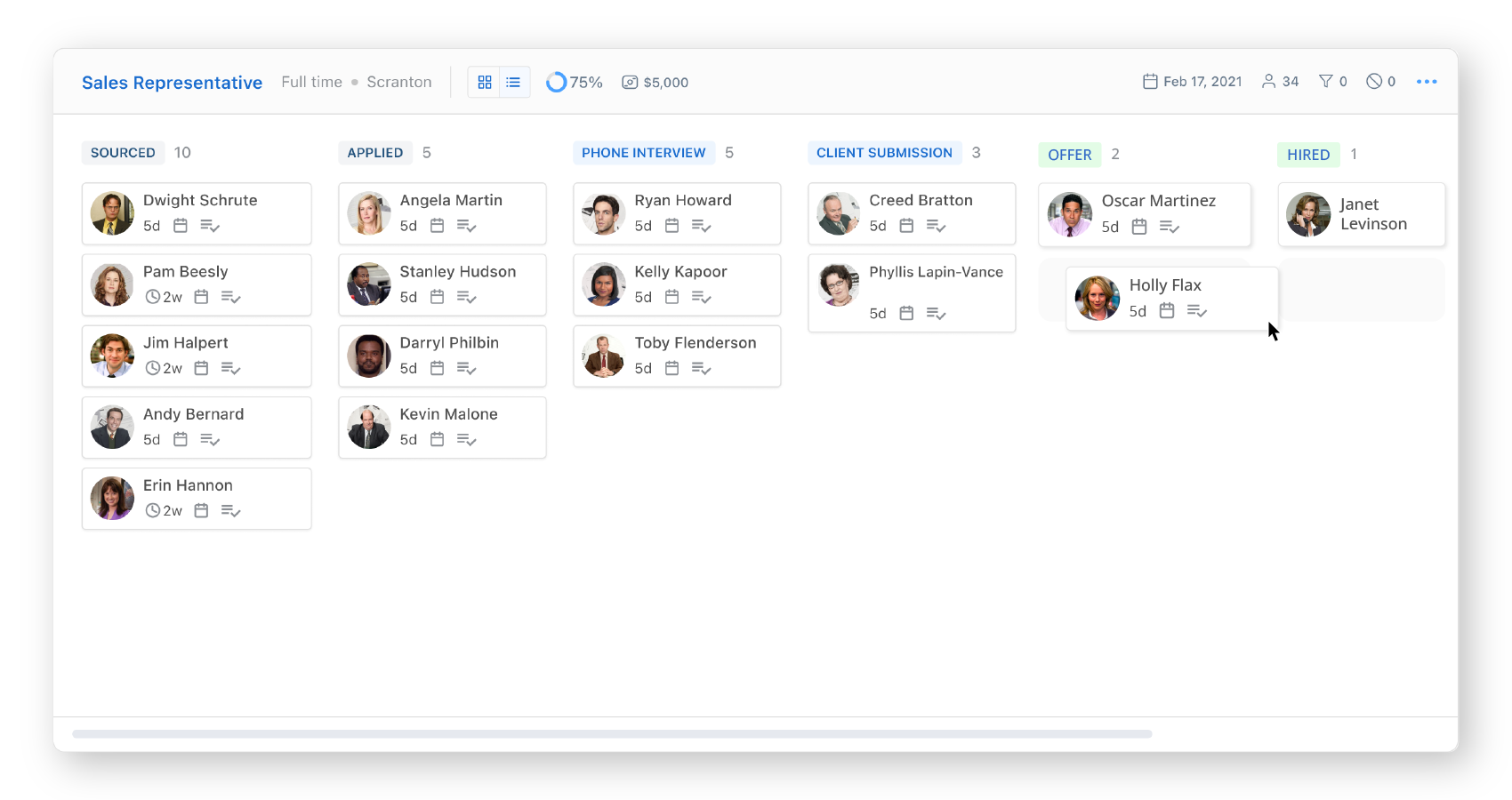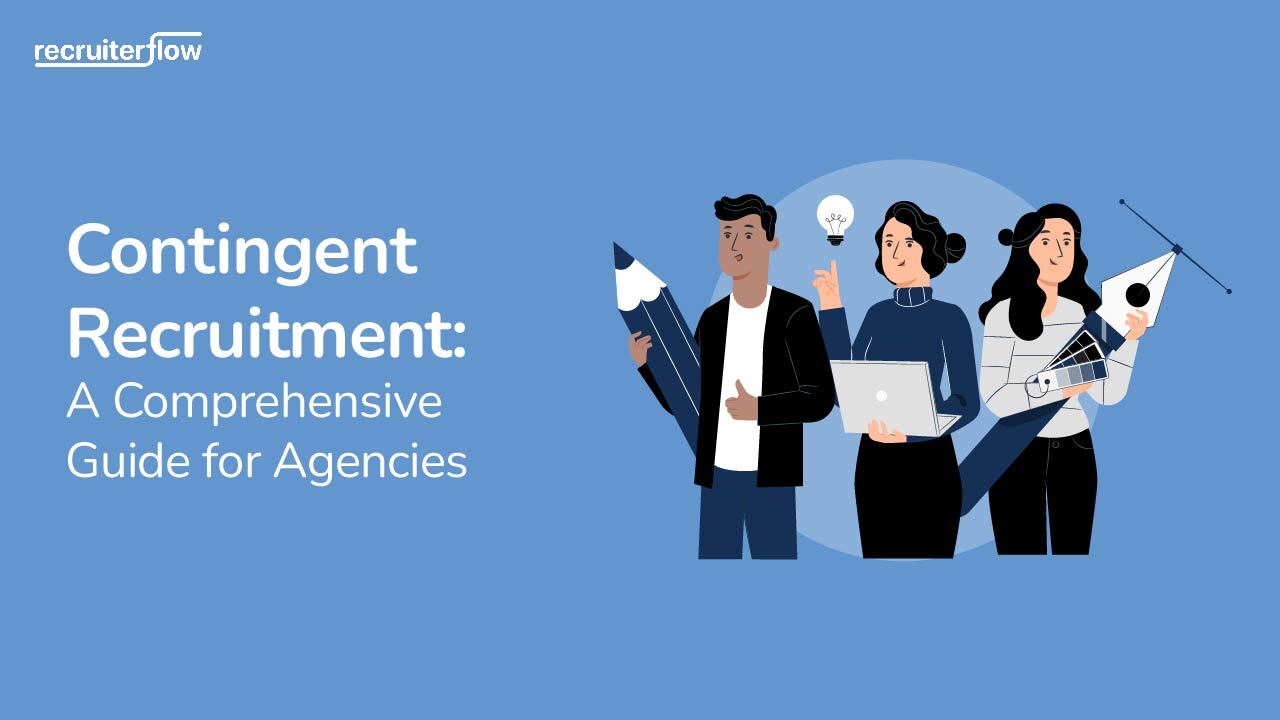
What is Recruitment Pipeline and How to Create One?

Recruiters often find themselves in a constant juggling act, balancing interactions with candidates and clients, sifting through applications, and ensuring a seamless hiring process. This intricacy begs the question: How can recruiters maintain efficiency, provide a stellar candidate experience, and stand out in an industry that often faces skepticism? Enter the recruitment pipeline—a structured framework designed to bring order to the chaos.
What is a Recruitment Pipeline
A recruiting pipeline serves as a visual representation of the sequential stages within your hiring process for a specific job position. It begins with sourcing, where candidates enter the pipeline. Successful candidates then go through stages like screening, assessment, and interviews. At each stage, the more qualified individuals move forward until one person is chosen for the job. It’s important to note that every agency or recruiter might have a slightly different recruitment pipeline tailored to their needs, but the general structure remains the same.
Stages involved in a recruitment pipeline

The recruitment pipeline consists of several stages that guide recruiters through the process of sourcing, screening, and selecting candidates for job positions. While specific terminologies and processes may vary, here are the general stages of a recruitment pipeline:
Identify hiring needs
This stage involves understanding the hiring requirements and goals of the organization. Recruiters work closely with hiring managers to define job roles, responsibilities, and qualifications.
Sourcing candidates
Recruiters actively search for potential candidates through various channels, such as online job boards, social media, professional networks, and referrals. This stage aims to build a pool of qualified individuals.
Application and resume review
Candidates who express interest in the positions submit their applications and resumes. Recruiters review these documents to ensure that candidates meet the specified qualifications and job requirements.
Screening and initial contact
Recruiters conduct initial screenings to assess candidates’ suitability for the positions. This may involve phone or video interviews to evaluate skills, experience, and cultural fit. Successful candidates proceed to the next stages.
Interviews and assessments
Candidates undergo more in-depth interviews, which may include behavioral interviews, technical assessments, or case studies. The goal is to further evaluate their qualifications and potential contributions to the organization.
Client interviews
Shortlisted candidates are presented to the client or hiring manager for final interviews. This stage involves ensuring alignment between the candidate’s skills and the organization’s needs.
Reference checks
Recruiters may conduct reference checks to verify a candidate’s work history, qualifications, and performance. This step provides additional insights into the candidate’s capabilities and professionalism.
Offer negotiation
Recruiters work with both the client and the candidate to negotiate compensation, benefits, and other terms of employment. This stage ensures that both parties are satisfied with the proposed offer.
Job offer and acceptance
Once terms are agreed upon, recruiters extend a formal job offer to the candidate. The candidate’s acceptance marks the successful conclusion of the recruitment process for that particular position.
Onboarding
The onboarding process begins after a candidate accepts the offer. Recruiters assist in the smooth transition of the new hire into the organization, ensuring they are equipped with the necessary information and resources for a successful start. This can include partnering with training video companies to develop customized onboarding video modules that introduce the company culture, key personnel, and essential workflow

Benefits of a recruitment pipeline
1. Proactive talent sourcing
Building a sturdy recruitment pipeline is like casting a wide net before the big catch. It allows you to spot and engage potential candidates well ahead of job openings, creating a reliable pool of qualified talent ready to dive in when needed.
2. Reduced time-to-fill
Maintaining a recruitment pipeline reduces the time to fill. Having pre-qualified candidates at your fingertips streamlines the placement process, ensuring you’re not caught flat-footed when clients call for reinforcements.
3. Elevated candidate Quality
Nurturing relationships with candidates over time through the recruitment pipeline is akin to aging fine wine. This leads to a deeper understanding of their skills, qualifications, and cultural fit, resulting in the selection of top-notch candidates who seamlessly align with both company and client needs.
4. Enhanced candidate experience
When adding candidates to the recruitment pipeline, recruiters can note specific details from their conversations. With these insights, recruiters can tailor interactions as candidates progress through the hiring process. The proactive and personalized approach fosters better engagement, increasing the likelihood of candidates not only accepting job offers but also forming lasting connections.
5. Cost-effective talent acquisition
Investing in a robust recruitment pipeline is akin to planting seeds for a bountiful harvest. Proactively identifying and nurturing candidates reduces the reliance on expensive last-minute recruitment efforts, optimizing resources and ensuring a fruitful yield.
6. Strategic workforce planning
Anticipating future talent needs through a recruitment pipeline is like chess, thinking several moves ahead. This allows organizations to align their efforts with growth trajectories, ensuring a steady influx of skilled professionals to support business expansion.
7. Flexibility and adaptability
A well-managed recruitment pipeline is a safety net that acrobats swear by. It provides organizations with the flexibility to adapt to changing requirements, whether facing sudden spikes in staffing demands or unexpected turnovers.
8. Enhanced reputation
Building a positive reputation through regular communication with potential candidates is like crafting a masterpiece. Candidates who feel valued and informed throughout the recruitment process are more likely to sing your praises, attracting top talent and bolstering credibility in the industry.
9. Diverse talent pool
Cultivating a diverse talent pool through the recruitment pipeline is like assembling a versatile toolbox. Proactively engaging candidates from various backgrounds ensures inclusivity, allowing organizations to meet the diverse staffing needs of their clients.
10. Continuous optimization
Regularly fine-tuning the recruitment pipeline is akin to maintaining a well-oiled machine. This commitment to constant optimization ensures that the recruitment process remains efficient, effective, and in tune with the evolving needs of both organizations and clients.
Also Read: Email Templates for each stage of your recruitment pipeline
How to build a recruitment pipeline
Creating a structured recruitment pipeline is an essential skill for recruiters looking to enhance efficiency and deliver an outstanding experience to both candidates and clients. Here’s a step-by-step guide on how to craft a well-organized recruitment pipeline:
Set clear hiring goals
Identify the specific needs of your clients and define your hiring goals clearly. This could range from high-volume entry-level positions to executive roles. Understanding these goals will shape the structure of your pipeline.
Choose the right tools
Utilize recruitment tools and platforms to streamline the process. Consider using dedicated recruitment software like Recruiterflow to track and manage candidate information systematically.
Strategize sourcing methods
Develop a robust sourcing strategy using a variety of channels. Leverage social media platforms such as LinkedIn and Facebook, explore online job boards like Indeed or Monster, and consider utilizing sourcing tools like Lucia or ContactOut to gather candidate information.
You can also check out our guide on the best recruitment marketing tools.
Implement a rigorous screening process
Weed out the best candidates by reviewing applications and resumes meticulously. Ensure that candidates not only possess the necessary skills but also align with the job descriptions. This step is crucial for saving time and resources in the long run.
Communicate often
Establish a structured routine for contacting potential candidates. This could involve regular emails, phone calls, and even text messages. Having a well-defined communication plan ensures that candidates remain engaged and informed throughout the process.
Prepare for interviews
Organize interviews efficiently by conducting thorough behavioral and technical interviews. Prepare candidates adequately for these interactions, providing them with a positive and professional experience.
Track and review consistently
Regularly review and update your pipeline to ensure it aligns with changing hiring goals. Consistent tracking of applications and resumes allows you to tap into a pool of potential candidates for future opportunities.
You can also check out our guide on Recruitment 360 and strategic recruitment plans to enhance your hiring strategy.
Metrics and Analytics for Pipeline Management
Figuring out which metrics to keep an eye on in your recruitment pipeline can show how well your hiring process is doing. It helps you see if your recruiting efforts match the client’s objectives where you should make changes to improve the quality of hires and how quickly you fill positions.
Pass-through rate
Pass-Through Rate (PTR) is a crucial metric in your recruitment pipeline, reflecting the percentage of candidates making it through each stage of the hiring process. It essentially tells you how good your process is at identifying and advancing the right candidates. A low PTR rate at a certain stage could indicate that there is difficulty at that specific stage and that the job posting needs to be tweaked slightly to rectify the issue.
Time to hire
This metric measures the average time it takes to fill a vacant position, from the job posting to the candidate accepting the offer. It tells you how quickly your recruitment process moves qualified candidates through the pipeline. A low TTH indicates a smooth and efficient hiring process, while a high one might suggest bottlenecks or ineffective practices.
Candidate experience
Candidate experience goes beyond the mechanics of your recruitment pipeline. It captures the holistic journey of a candidate from initial awareness of the job posting to the final decision to accept or decline an offer. Measuring candidate experience is a crucial factor for a recruitment agency to attract and retain top talent.
Recruitment





Sagrika Jain